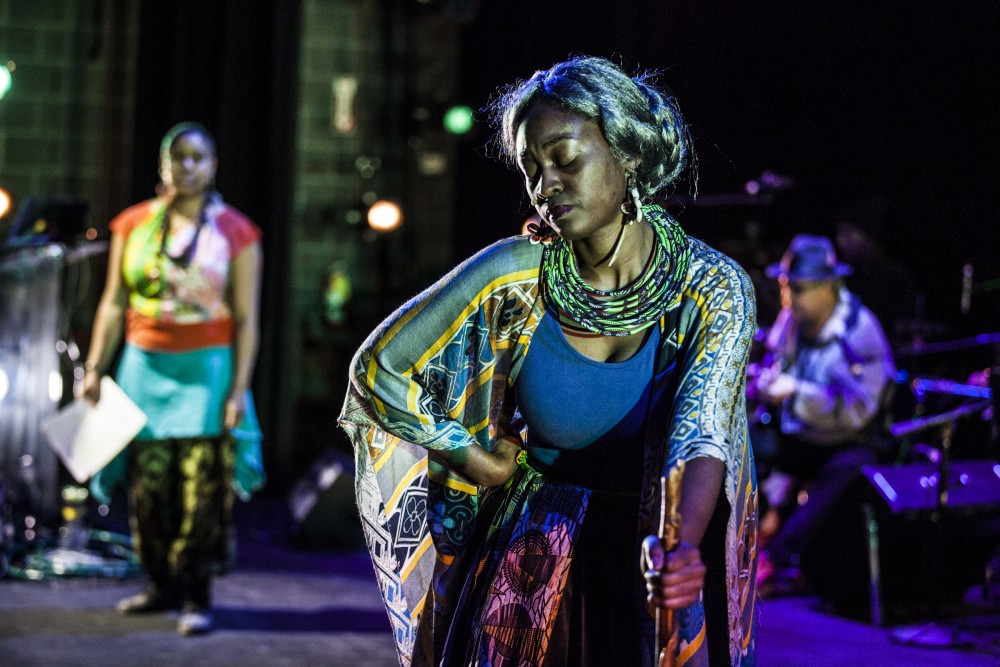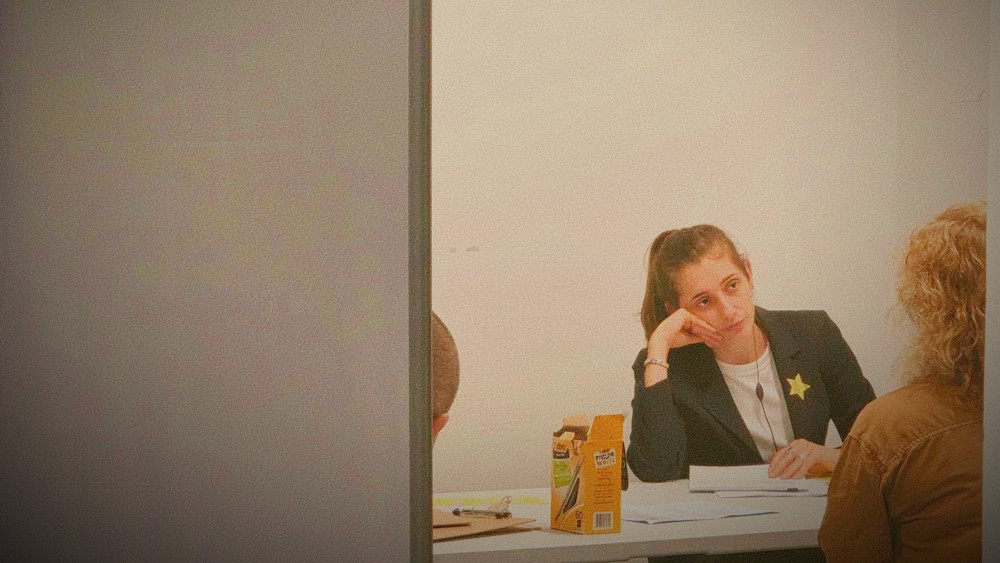In January 2015, performance artist Aisha Cousins collaborated with Greg Tate and his band, Burnt Sugar, to bring two performances of “Brer Rabbit the Opera: A Funky Meditation on Gentrification” to the BRIC House Fireworks Residency, which allows artists from different disciplines to create works in (and often about) Brooklyn.
Inspired by the Fluxus artists from the mid-20th century, Cousins — a graduate of Oberlin College — spent time as a mural painter before committing to performance art in 2007. She approached “Brer Rabbit” as a means to engage and provoke community responses to gentrification in the Brooklyn’s historically black Bed-Stuy neighborhood. Employing methods such as crowd sourcing and interviewing, Cousins and her collaborators created a piece that empowered people to examine the ways in which we interact with one another.
Amelia Parenteau spoke with Cousins about the process of creating “Brer Rabbit” from first-hand research, as well as what the future holds for the project and the community from which it arose.
AMELIA PARENTEAU: With “Brer Rabbit the Opera,” you used a classic children’s story to address ongoing issues of gentrification and displacement. What did that look like?
AISHA COUSINS: The premise of the plot is that there’s a middle-aged black man on the tipping point of his battle, his longtime battle with the American Dream. He’s moving into a neighborhood that is notoriously dangerous, a predominantly black neighborhood known as the Briar Patch, which is at its tipping point with its longtime battle against gentrification. And the idea is that, through the residency, we would work with the public to collaborate. The public had a voice, I had a voice, Greg had a voice, and we would mix it all together to determine how the main character and the people in the neighborhood, how their stories would intertwine, how the main character and the neighborhood would intertwine, and which way their battles would tip.
AMELIA: You come from a performance art background, and I’m curious about your collaboration with Greg Tate and Burnt Sugar. Were you interested in working with a musician specifically? How did you two meet?
AISHA: It was through LaRonda Davis, a mutual friend of mine and Greg’s from the Black Rock Coalition. Greg is one of the founders of the Black Rock Coalition, and one of the reasons I was drawn to the BRIC residency was because I was looking for opportunities to collaborate with a musician, and that was really hard to come by. To actually be in a residency that, that’s what the residency was made for, was really wonderful.
I had been talking about doing a performance art score, kind of a concert/performance art score mingled with music and other different pieces that made it seem like it could be packaged as a concert, but really a way of presenting performance art to audiences that might not otherwise necessarily be the people who are like, “I’m going to go see a performance art piece.”
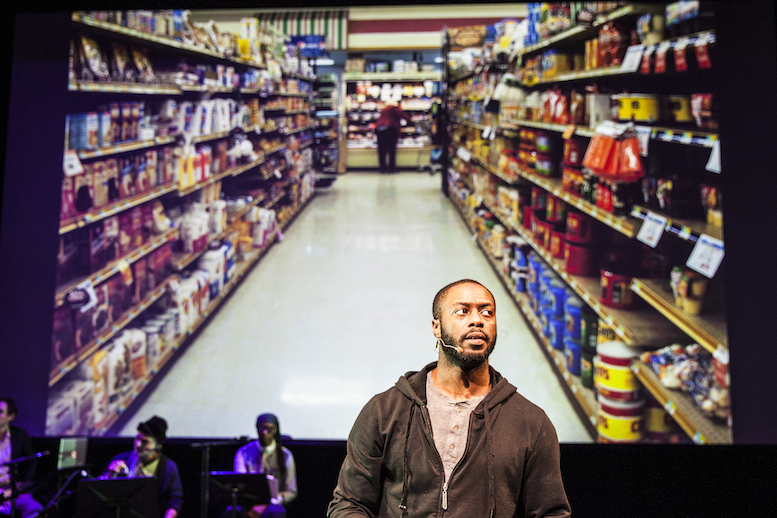
AMELIA: When you talk about performance art scores, are you talking about what might be considered a script in a traditional theater piece?
AISHA: No, the script is something else. But I write these things that are somewhat like recipes. If you’ve ever seen Fluxus scores — if you look up Fluxus Artists, those types of instructions. They have a certain question that they’re posing, or a certain focus, subject matter, and so on. But at the same time, there’s all this room in them for people to respond to that and gain from it what they want — kind of instructions for a live art piece.
When I was going around doing the performance art scores, I wasn’t necessarily going around telling people the entire plot every time, but I would say things like, “How do you feel when people say, ‘Your neighborhood isn’t beautiful,’ or ‘Your neighborhood isn’t valuable?’” “What are beautiful things?” “What are things of value in your neighborhood?” And then taking those responses and leaving them to talk.
What I like about performance art and making performance art scores is that they are meant to be interpreted by other people. Every time people reinterpret them, they have the opportunity to make them specific to the site and to their own experiences that they’re having in that moment. I was really interested in that, because the demographic that I’m aiming towards was certain people who are not necessarily the target audience for things that are labeled performance art.
AMELIA: So when you and Greg were conceiving the piece for the BRIC residency, what did your process look like? How did your performance art scores feed the creation of the opera?
AISHA: I came to Greg, and I was like, “I want to do performance art scores presented in a way that, if someone isn’t keen on performance art — not anti, but they had ideas — they could be like, ‘It’s a concert!’”
I had these performance art scores. For instance, I would have like a big suggestion box with a sign above it, and I would have models of things. And I would say, “This is a Brer Rabbit sculpture… Do you have a place that you love that others consider dangerous? Brer Rabbit had the same problem. Outsiders labeled the briar patch dangerous because of its thorns. Brer Rabbit, however, loved the briar patch because it kept him safe from predators and made a safe place for his family to grow. Write down a beautiful thing that grows in your neighborhood to add it to our culture.”
And so I showed Greg a few of the scores, and once he saw the Brer Rabbit one he was like, “That one. I think we should do an opera.” I think it turned out to be more of a combination between a musical and a play when it was all said and done. I think the reason why opera turned out to be a good term was because Burnt Sugar just makes such beautiful music, and, in that sense, it’s indicative of how I like to work with people. I don’t like people to be pegs that plug into a project. I like to be like, “What are you interested in? What are you working on? What’s your aesthetic?”

AMELIA: How much did you consider the potential audience for the piece when you and Greg were shaping it?
AISHA: I think the work that I made was always geared primarily towards black audiences, and I kind of had to get used to the fact that I needed to say that, because a lot of times, even if work is about black folk, people don’t see it as being geared towards black folks primarily and then secondarily towards other people who might be seeing it. Like, if you’re making TV shows geared towards first generation Asian immigrants, you have to say, “This is my primary target audience.” And everybody else who watches it and gets something from it, that’s great, but it helps you understand why the conversations are what they are. And it helps you understand that it’s not a free conversation in terms of the thought process.
When I was in college, I had an interesting conversation on the train platform with a classmate of mine, a woman, and we were talking about this professor who we both really liked named James. He taught Black History 101, and I thought it was a total waste of his knowledge and his thinking capacity to have him be like, “Let me teach you about Harriet Tubman.” A total waste. It’s really American history people should know by the time you get out of high school. Everybody should know who Martin Luther King is, and Malcolm X is, who Harriet Tubman was, who Frederick Douglass was. You should know those things.
When we start the conversation with the assumption that people don’t know those things, what we do is we slow the evolution of things, you know? It’s just repeating what should, at this point, be basic knowledge. I don’t think I ever really felt like I had to frame my work in that way, and I never really felt like I had to explain why I didn’t want to frame my work that way, or explain that this is a conversation between people who have very specific, have a wealth of experiences. And if you don’t, it’s not your problem. And I think that, yeah, at some point I had to say that for people to get that. But I think it’s good for everybody. I think it’s good, like a foreign language immersion trip, it’s the best way to learn a foreign language.
I don’t know if you have friends who are in different fields than you, but I have one friend who’s a biologist who would water things down for me in conversation, and I would say, “No, no, don’t water things down for me. I’ll catch up. You should push me to work my brain.”
AMELIA: How do you feel that your investigation specifically engaged the community and created conversations about gentrification?
AISHA: It was really just me going out and talking to people and getting their feedback and then meeting with Greg, trying to filter down and look at them from a qualitative point of view, trying to determine what would be really be compelling to see.
There was this one story, and we actually got a complaint about it. The comment we got was from a woman who’s German saying that the section that was in German had a really aggressive tone to it. But the character was based on something that really happened, and I wrote back to her and explained I really appreciated her feedback, because she said it played into stereotypes about Germans and ethnic colonies.
There’s a character who’s black, and then there’s another character who is new to the neighborhood, who’s German, and finds that this black character has a family member who is German and proceeds to have a conversation with him in German, because he’s like, “You must be able to understand and relate to me,” about how upset he is that he bought this house and felt gipped and cheated that it’s uninhabitable. A shell of a house, and he can’t live in it. He’s going to have to do all this work and pay all this money. The German says, “But worst of all, there are so many black people! So many black people left, and the agent told us the black people would be gone.” And when I heard it, I was like, “That’s going in.”
It sums up a lot of things actually, in terms of outside investors coming into the country and buying things sight unseen. Because it’s about what they want to do. There’s a really weird dynamic of foreign, concentrated, speculative money being poured into neighborhoods. And then those value judgments of, “These black people need to move out of the way,” or “We need to get them out of here,” or “We can do better.”
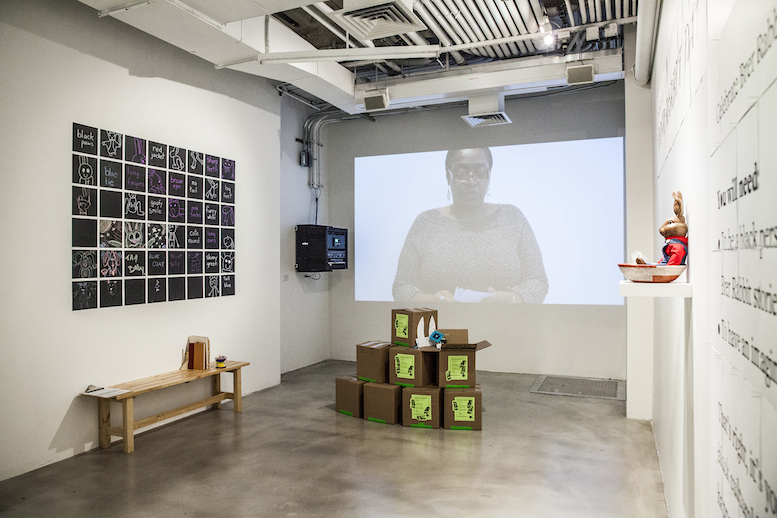
AMELIA: What were your hopes for the impact of this piece on the community?
AISHA: I think I was hoping it would be a processing tool that people could use. I’m seeing my neighborhood gentrify around me, and it makes me sad. I’m not as sad now actually, now that we’ve done the project. I think it helped me process a lot.
There’s a point where the real estate agent character goes at it from a different angle, explaining gentrification as a human thing, like humans do this to each other, and if we’re more aware of it when it’s happening to us, we’ll be more aware of when we’re doing it to other people. But I think that that’s important in terms of its function, because if it’s going to affect somebody who’s coming here and is like, “I don’t understand why gentrification is a problem,” you really can’t have it be like, there’s a bad guy and a good guy, and you’re the bad guy, and you need to stop what you’re doing.
Culture is very subjective. We Americans tend to be in such a bubble culturally that we’re not really looking at ourselves, or that other people do things differently than we do. When we encounter people who do things differently, we’re like, “That’s weird.” We don’t realize how many people in the world do that and how there’s a philosophy behind that. Even if it’s not a vocalized philosophy, it’s a way of doing things — just realizing there’s no right way or wrong way, just a lot of different ways. A lot of the issues that people have with gentrification would dissipate if you took away that concept of right or wrong, good or bad, civilized or uncivilized culture. That’s where I wanted it to come from, in terms of my end, making the performance art scores. And I think we did a good job, making tools that people can use.
AMELIA: Do you see a future life for it? Do you have future plans for putting it up again?
AISHA: We’re just trying to figure that out. I didn’t know much about theater things because that’s not really my field. I did the interviews, and Greg did the music and lighting. And we came together because of this residency, but what I’ve come to realize is that we are kind of backwards in our process, because we started with a lot of resources that are not usually available at this stage of the process. We were able to pay everyone for rehearsals and performances. It’s usually very low budget, and so step two would be a step backwards, in terms of the people who are involved and what they are expecting. People are very excited about it, but, you know, you don’t want to go to people and say, “I’m going to pay you like a quarter.” You can’t really do that to people. Everybody that was involved was really excited about it, but they all have other projects, too. I feel like at some point it will come back around, but it may not be as soon as we would like it to be.
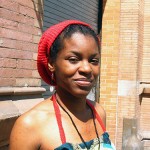 Aisha Cousins is a Brooklyn-based artist. She writes performance art scores (do-it-yourself art projects) that engage black audiences from different backgrounds in exploring their ideas about beauty and processing the changes taking place in their worlds. Her interactive, public performance art scores have been performed on the streets of historically black neighborhoods from Bed-Stuy to Brixton, as well as inside institutions such as the Museum Of Contemporary African Diasporan Arts, the Brooklyn Museum of Art, Houston’s Project Row Houses, and the internationally renowned Kitchen. Cousins’ work has been featured on television and in print, including coverage in the New York Daily News, the New York Times and the Studio Museum in Harlem’s Magazine.
Aisha Cousins is a Brooklyn-based artist. She writes performance art scores (do-it-yourself art projects) that engage black audiences from different backgrounds in exploring their ideas about beauty and processing the changes taking place in their worlds. Her interactive, public performance art scores have been performed on the streets of historically black neighborhoods from Bed-Stuy to Brixton, as well as inside institutions such as the Museum Of Contemporary African Diasporan Arts, the Brooklyn Museum of Art, Houston’s Project Row Houses, and the internationally renowned Kitchen. Cousins’ work has been featured on television and in print, including coverage in the New York Daily News, the New York Times and the Studio Museum in Harlem’s Magazine.
Author
-

Amelia Parenteau is a writer, French-English translator, and theater maker with a passion for social justice, based in New Orleans. An alumna of Sarah Lawrence College, she has worked with Ping Chong + Company, The Civilians, the French Institute Alliance Française (FIAF), The Lark, the New York International Fringe Festival, the Park Avenue Armory, and Theatre Communications Group in New York City, as well as Trinity Repertory Company in Providence, RI, People's Light in Malvern, PA, the Eugene O'Neill Theater Center in Waterford, CT, the Théâtre du Soleil in Paris, France, and Intramural Theater and No Dream Deferred in New Orleans, LA. Her writing has been published in numerous publications including American Theatre Magazine, Contemporary Theatre Review, and HowlRound. www.amelia-parenteau.com
View all posts


